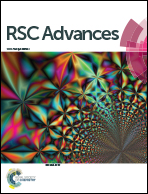Sonochemistry-synthesized CuO nanoparticles as an anode interfacial material for efficient and stable polymer solar cells†
Abstract
Solution-processible copper oxide (CuO) nanoparticles have been synthesized via sonochemistry. Colloidal crystalline CuO nanoparticles with diameters of 3–12 nm were obtained from the CuCl2 metal salt at low temperature under ultrasound irradiation. The solution-processible CuO nanoparticles are applied as an anode buffer layer in a PCDTBT:PC71BM bulk heterojunction solar cell to substitute the commonly used hygroscopic PEDOT:PSS. It is found that UV–ozone treatment increases the work function of the CuO buffer layer from −4.7 to −5.4 eV, facilitating the interfacial contact and hole extraction. The UVO-treated CuO-based solar cells show enhanced fill factor and photocurrent, resulting in an increased photovoltaic performance from 6.00% to 6.44% in comparison to the PEDOT:PSS-based solar cells. Moreover, the solar cells with a CuO buffer layer show better ambient stability than those with a PEDOT:PSS buffer layer. The facile preparation of solution-processed CuO and effectiveness in polymer solar cells render it a promising anode interfacial material for solution-processed flexible polymer solar cells.


 Please wait while we load your content...
Please wait while we load your content...